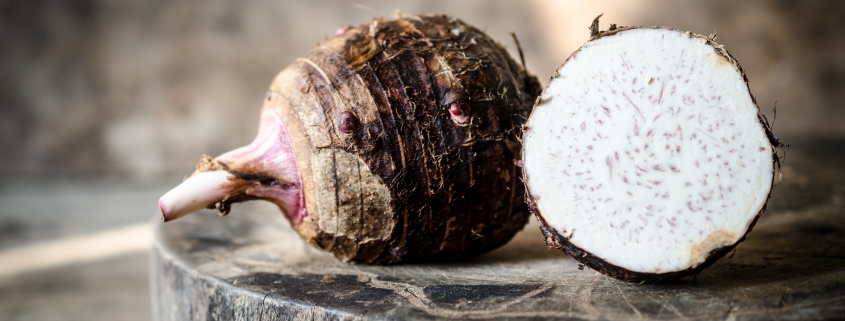Unfamiliar AIP Foods
If you’re new to the AIP you’ve likely started seeing recipes with some pretty unusual sounding ingredients – getting confused yet? Don’t worry, I’ve got you! I get a lot of questions about the following list of unfamiliar AIP compliant foods, so I’m going to provide you with some resources to help you on your way.
As a bit of a heads-up, these foods may not always be readily available at your local grocery store – you may need to check places like Whole Foods, Health Food Stores, Asian markets or seek them out in an online shop. In some cases, sadly, you just may not be able to find them in your area … ever … so you may need to consider alternate recipes if you run up against them.
Sweet Potatoes
While sweet potatoes in themselves are not an unfamiliar food, there are varieties that you may not be familiar with … like the elusive “white sweet potato,” for one. Check out this article that includes images depicting several (not all) varieties – Types of Sweet Potatoes and Why You Should Be Eating Them so you can more easily identify your options when you hit the shops (lots of regular grocers carry them, but you can typically find them in shops like Whole Foods and Asian markets). You may find in your area that you can find Caribbean or Jamaican varieties – these are similar in appearance to the Japanese variety. I personally find that the white fleshed varieties provide a texture that is more similar to a regular potato and they tend to be less sweet than a regular sweet potato/yam. If you have your eye on the purple sweet potatoes, those are kind of fun, and you can find a few recipes posted in the AIP Recipe Collection Facebook Group as well. If you’re in the USA and have access to Amazon, check out my AIP Storefronts under “Groceries.”
Plantains
These banana lookalikes are crazy amazing and pretty much have AIP Super-Powers! This is probably one of the unfamiliar foods I’m most grateful to have found on the AIP. Depending on their ripeness they can be used in all kinds of baked goods and dishes – from potato salad and potato chip substitutes to waffles, pancakes, cake, rice, nacho replacements and so much more! You’ll find LOTS of recipes that call for them in the AIP Recipe Collection Facebook Group, but first, take a moment to get acquainted with their health benefits here – Plantains: 7 Reasons to Add to Your Diet (NOTE: The recipes linked at the bottom of the article are not necessarily AIP compliant). Intrigued? Learn more about how to peel and prepare plantains here – Plantains 101. Ready to get cooking? Check out this recipe round up that includes recipes from around the web and how to use plantains at various stages of ripeness, and even recipes that use plantain flour – Plenty of Plantains – Over 200 AIP Plantain Recipes.
Cassava / Yuca
You’ll find Cassava flour is called for in a LOT of AIP baking recipes – it’s probably THE go-to flour for recipe creators because it reacts the most like a traditional flour. Cassava can sometimes be confused with Tapioca Flour/Starch, but you should know that the two are very different things and can not be used interchangeably in all cases, so I encourage you to read my post – Arrowroot vs. Tapioca vs. Cassava. Cassava / Yuca root/tuber is so much more than just a great flour! It can be used as a potato substitute, you can make pizza crust out of it and even french fries! You can buy it as a root/tuber in the produce section or pre-prepared (peeled) in the freezer section. As a word of warning, these guys are a challenge to peel and prep, but it can be done. Learn more about them in this article – Cassava (Yuca) 101 (NOTE: The recipe included on this page is NOT AIP compliant – I’m sharing it for the info about Yuca and how to clean and chop it, so circle back to the AIP Recipe Collection Facebook Group if you’re looking for ways to use your new-found friend!)
Eddoes / Taro
Wait, what? Ed who? This is another tuber/root that you’ll find in fewer AIP recipes, but it appears to be used similarly to cassava/yuca – mashed, as fries or root chips, in stir-fry, soup or stew, as a breakfast potato in a hash, etc. – so, basically another great potato alternative! It has some amazing health benefits that you can read about here – Asian Superfood: The Impressive Health Benefits of Taro Root. You will find a few recipes for it in the AIP Recipe Collection Facebook Group – try searching Eddoe and Taro.
Tigernuts
Hold the phone … nuts!? Well, they’re actually not nuts … Tigernuts are a tuber, and you’ll find them used in all kinds of AIP recipes. While they can be eaten as a snack (as a whole Tigernut), they are quite hard, so you’ll maybe want to try them in flake or flour form, used in baked goods, granola and even transformed into a replacement for peanut butter or nut milk! Tigernuts are reminiscent of almonds and can be used in place of almonds/almond flour/almond milk. Depending on where you live, you may find these to be quite pricey, but you may consider them/it a worthwhile investment as they do create some delicious goodies. As with everything there are up-sides and down-sides to using something less familiar, so you’ll need to take it slow with Tigernuts to determine if they’re right for you (those with digestive issues or sensitivities to high-fiber foods might experience discomfort using them). Want to learn more about them, check out this information on Tigernuts USA and then check out this article from Healthline, and then head over to the AIP Recipe Collection Facebook Group where you’ll find lots of inspiration on how to use them in conjunction to your AIP healing journey. Looking for where to buy them? I enjoy TigerNuts USA – check them out here.
Jicama
Pronounced, hee-cama, this root vegetable is a little different than the tubers mentioned above – it can be eaten raw! It’s high in prebiotic fiber, low in starch, sugar and carbs compared to other root veggies – it’s similar in taste and feel to very crisp apple. Learn more about its health benefits here – Jicama: Full of Prebiotic Fiber, It Helps Weight Loss, and then more about how to prep and use it here – Jicama Is Probably the Most Exciting Vegetable You’re Not Eating. You will find a number of recipes that incorporate Jicama over in the AIP Recipe Collection Facebook Group where it’s used in breakfast hash, salads, salsa replacements, as a dessert, fries, hash browns and more!
Tamarind
But wait, it’s a pod with seeds in it – isn’t it a legume! How can this be compliant? Well, yes, it is a pod-like fruit and considered part of the legume family … but when we talk about tamarind in the AIP world, we’re just talking about the pulp of the outer pod that’s made into tamarind paste – that IS compliant. Want to learn some of the benefits of consuming Tamarind – take a look at this article from Healthline. Ok, but what on earth is it used for? Tamarind paste is high in tartaric acid which adds a tart, sweet or sour taste to dishes which makes it a great addition to a no-mato sauce, no-mato ketchup or BBQ sauce, marinades, curries or other Indian, Thai, Asian and Mexican dishes. This little gem offers a more exotic and complex taste profile than just using lemon or vinegars. Want to try it out? You can find tamarind paste/puree in our affiliate shop- click here.
Gelatin Eggs
Okay, so this isn’t exactly a food you can go out and buy (don’t laugh, I’ve been asked where to buy gelatin eggs), but it’s an ingredient you’ll see listed in AIP recipes and I want you to be aware of what it is, how to make them and how they’re used. You can learn more in my dedicated post – Egg Replacements.
Cream of Tartar
Here’s one you may not have come across a lot on the SAD (Standard American Diet), but you’ll see crop up a lot more in AIP baking. I get asked a LOT if there’s a substitute for it (because it’s not something folks tend to keep on hand) – unfortunately, it’s unique and there is no substitute … so, if you don’t have some on hand, you may want to pick some up (You can find it in our affiliate shop – click here). What’s it used for? when used in combination with baking soda/sodium bicarbonate it becomes a leavening agent – the stuff that makes baked goods puff up in the oven. Basically, this combination creates an AIP compliant baking powder. So, why can’t we just use regular baking powder, you ask? Traditional brands contain cornstarch (a no-no on the AIP) and sometimes aluminum in the baking soda (I try to use aluminum free baking soda – You can find aluminum free baking soda in our affiliate shop – click here).

